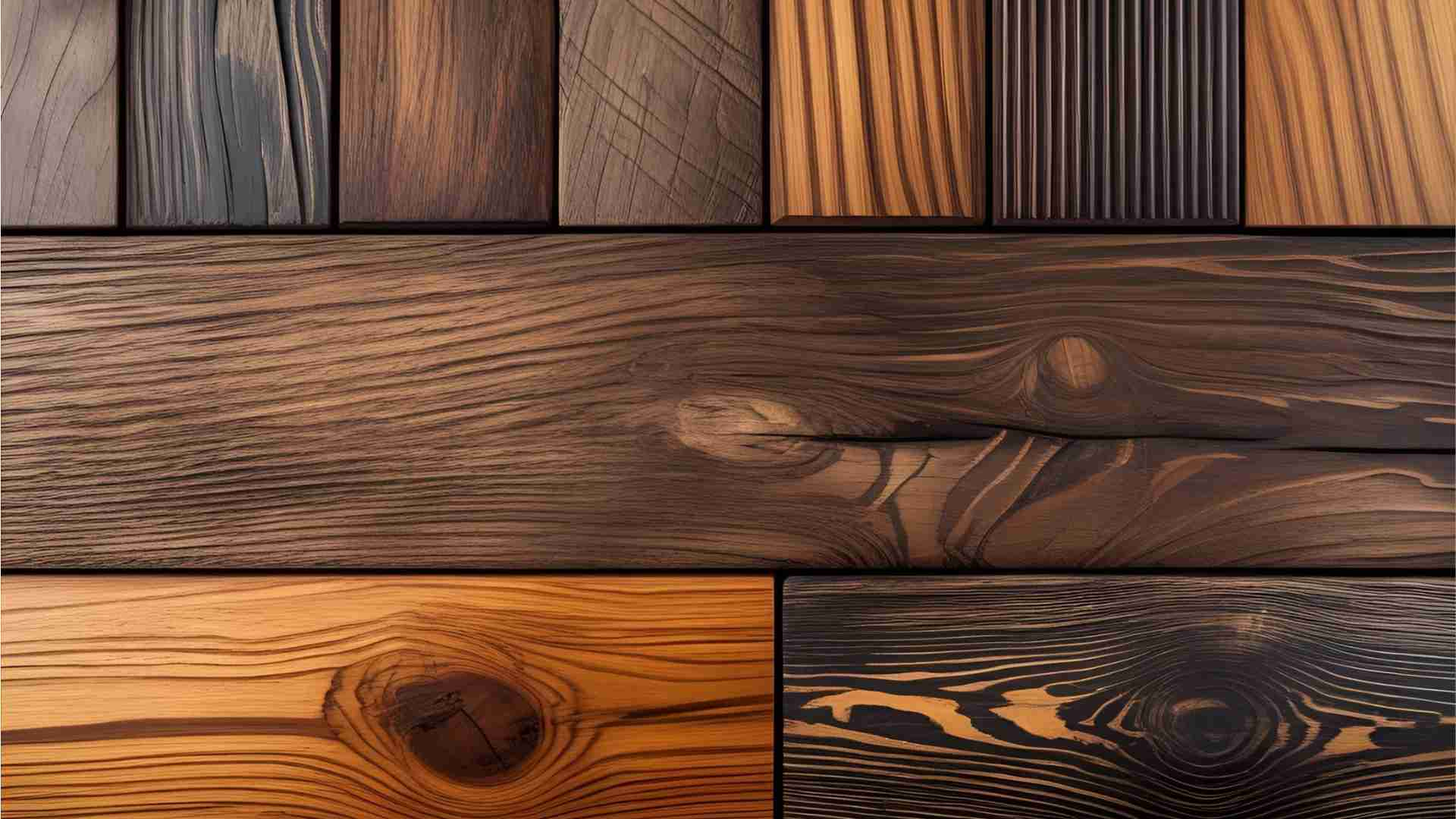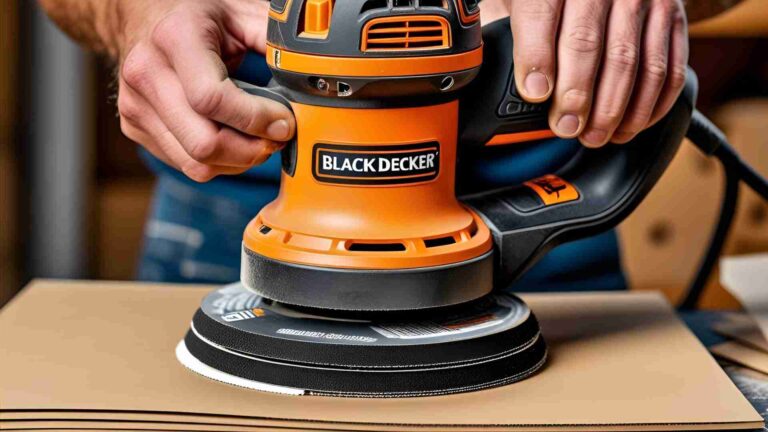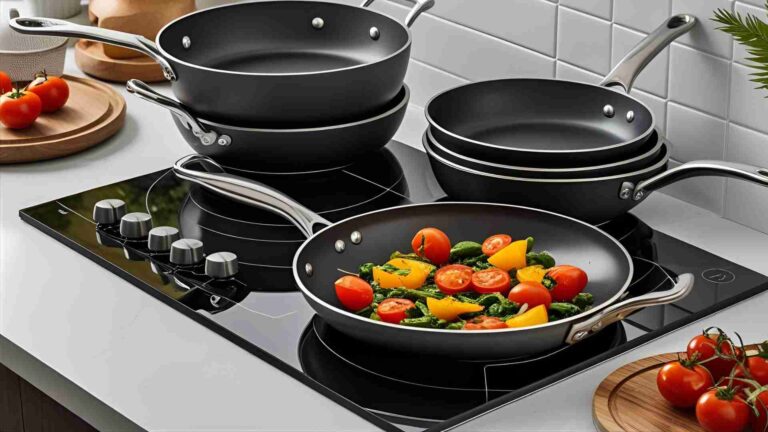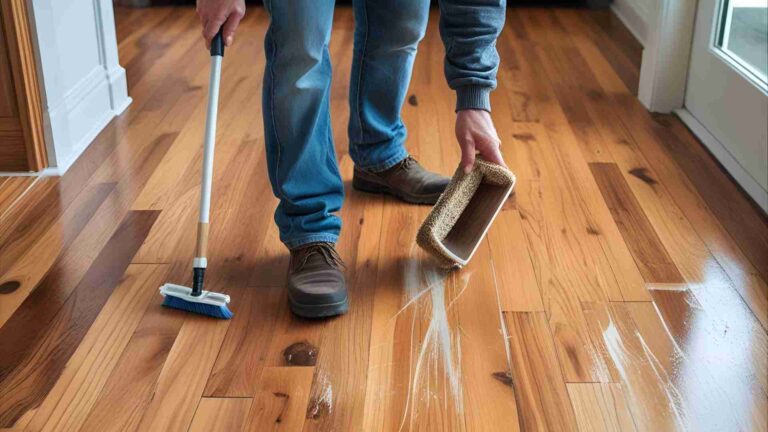Pros and Cons of Different Wood Types for Furniture
Discover the pros and cons of wood types for furniture, including pine, oak, walnut, and more, to choose the best for your home.
Wood has been a cornerstone of furniture making for centuries, valued for its strength, versatility, and timeless beauty. Whether crafting a rustic farmhouse table or an elegant dining chair, the type of wood you choose significantly impacts the piece’s durability, aesthetic, and cost. With countless wood varieties available, selecting the right one for your furniture can be overwhelming. This guide explores the most popular hardwoods, softwoods, and engineered woods used in furniture, detailing their pros, cons, applications, and approximate costs to help you make an informed decision.
Why Wood Choice Matters for Furniture
Furniture is an investment, and the wood type determines its longevity, maintenance needs, and visual appeal. Hardwoods like oak and walnut offer durability for high-use items, while softwoods like pine provide affordability for casual pieces. Engineered woods, such as plywood, balance cost and stability. Understanding the characteristics of each wood type ensures your furniture aligns with your budget, style, and functional needs.
Hardwoods: Strength and Elegance
Hardwoods, derived from deciduous trees, are known for their density, strength, and intricate grain patterns. They are ideal for high-quality furniture due to their durability and aesthetic appeal but often come with a higher price tag. Below, we explore the most common hardwoods used in furniture making.
1. Oak
Oak is a durable hardwood prized for its strength and distinctive grain. Available in red oak (light brown to pinkish-red with a swirling pattern) and white oak (tiger-stripe grain with yellow flecks), it’s a staple in furniture like dining tables and cabinets, especially in Arts and Crafts or Mission styles.
Pros:
- Durability: Oak’s density makes it resistant to wear, ideal for heavy-use furniture like dining tables.
- Versatile Grain: Quarter-sawn oak offers a linear grain pattern, perfect for modern designs.
- Rot Resistance: White oak, in particular, resists water damage, making it suitable for outdoor furniture.
- Mid-Range Cost: Oak is more affordable than premium hardwoods like walnut, typically priced at $5–$10 per board foot.
Cons:
- Grain Exaggeration: Stains can over-darken oak’s grain, creating a two-toned look.
- Splintering: Oak can splinter if not cut with sharp tools, requiring careful craftsmanship.
- Maintenance: Regular sealing is needed to prevent warping or cracking.
Applications: Dining tables, chairs, cabinets, flooring, and outdoor furniture.
Price: $5–$10 per board foot for red oak; $8–$15 for white oak.
2. Walnut
Walnut, with its rich chocolate-brown to yellow hues, is a premium hardwood known for its strength and intricate grain. Often clear-coated to highlight its natural beauty, it’s a top choice for high-end furniture like headboards and antique-style tables.
Pros:
- Aesthetic Appeal: Its deep color and smooth grain create a luxurious look.
- Strength and Stability: Walnut supports intricate carvings without splitting.
- Workability: Easy to shape and polish, ideal for detailed designs.
Cons:
- High Cost: Priced at $10–$20 per board foot, walnut is among the more expensive hardwoods.
- Color Variation: Some may dislike the light-to-dark variation on a single board.
- Scratch-Prone: Despite its strength, walnut can dent or scratch under heavy use.
Applications: Headboards, dining tables, mantels, and cabinetry.
Price: $10–$20 per board foot.
3. Maple
Maple, a creamy white hardwood with occasional reddish tinges, is one of the hardest woods used in furniture. Its durability makes it ideal for high-traffic pieces like dressers and kitchen cabinets.
Pros:
- Ultra-Durable: Maple withstands heavy use, perfect for furniture that endures daily wear.
- Affordable: Priced at $6–$12 per board foot, it’s a cost-effective hardwood.
- Staining Versatility: Takes dark stains well, mimicking pricier woods like cherry or mahogany.
Cons:
- Blotchy Staining: Improper sealing can lead to uneven stain absorption.
- Limited Grain Variation: Its subtle grain may lack visual interest for some.
- Deforestation Risk: High demand for maple can strain sustainable sourcing.
Applications: Dressers, kitchen cabinets, butcher blocks, and flooring.
Price: $6–$12 per board foot.
4. Cherry
Cherry, ranging from reddish-brown to blond, is a hardwood with a fine, straight grain. Its rich color deepens with age, adding elegance to furniture like Shaker-style tables and carved chairs.
Pros:
- Rich Color: Unstained cherry offers a warm, luxurious aesthetic.
- Workability: Easy to shape and polish, ideal for intricate designs.
- Aging Beauty: Darkens over time, enhancing its appeal.
Cons:
- Expensive: Priced at $8–$15 per board foot, it’s costlier than oak or maple.
- Light-Sensitive: Prolonged sun exposure can alter its color unevenly.
- Prone to Movement: May warp if not properly dried or maintained.
Applications: Carved chairs, tables, cabinets, and musical instruments.
Price: $8–$15 per board foot.
5. Mahogany
Mahogany, a reddish-brown hardwood with a close grain, is synonymous with luxury. Its use in high-end furniture and musical instruments is tempered by its endangered status due to overharvesting.
Pros:
- Attractive Grain: Offers a sophisticated, warm appearance.
- Durability: Resistant to wear and stable over time.
- Workability: Easy to carve and finish, ideal for detailed furniture.
Cons:
- High Cost: Priced at $12–$25 per board foot, reflecting its scarcity.
- Environmental Concerns: Honduran mahogany is endangered, limiting availability.
- Heavy: Its density can make large pieces cumbersome.
Applications: High-end furniture, cabinetry, and musical instruments.
Price: $12–$25 per board foot.
6. Ash
Ash, a light-colored hardwood with an open grain, combines flexibility and strength. It’s used in furniture, cabinets, and even sporting goods like baseball bats.
Pros:
- Flexible and Strong: Ideal for curved furniture designs.
- Affordable: Priced at $5–$10 per board foot, it’s budget-friendly.
- Light Aesthetic: Creates an airy, open feel in spaces.
Cons:
- Warping Risk: Susceptible to moisture-induced warping.
- Insect Vulnerability: Less resistant to pests than other hardwoods.
- Lower Rot Resistance: Not ideal for outdoor use without treatment.
Applications: Furniture, cabinets, and sporting goods.
Price: $5–$10 per board foot.
7. Beech
Beech is a strong hardwood with a smooth texture and light color. Its ability to mimic pricier woods like mahogany makes it a versatile choice for furniture.
Pros:
- Strong and Hard: Suitable for heavy-use furniture.
- Affordable: Priced at $4–$8 per board foot.
- Staining Versatility: Mimics more expensive woods effectively.
Cons:
- Moisture Sensitivity: Prone to damage in humid environments.
- Difficult to Work: Requires sharp tools for handwork.
- Subtle Grain: Lacks the dramatic patterns of oak or walnut.
Applications: Furniture, flooring, and cabinetry.
Price: $4–$8 per board foot.
8. Mango
Mango wood, a sustainable hardwood, offers golden-brown hues and water resistance. Its affordability makes it popular for furniture and decorative items.
Pros:
- Sustainable: Sourced from fast-growing mango trees.
- Durable: Resists wear when properly treated.
- Affordable: Priced at $5–$10 per board foot.
Cons:
- Fungus Risk: Susceptible to fungal growth without treatment.
- Outdoor Limitations: Requires sealing for exterior use.
Applications: Furniture, ornaments, and musical instruments.
Price: $5–$10 per board foot.
9. Acacia
Acacia, known for its hardness and water resistance, is a durable hardwood used in flooring and household items like cutting boards.
Pros:
- Durable and Water-Resistant: Ideal for high-moisture environments.
- Attractive: Offers rich, varied grain patterns.
- Sustainable: Sourced from fast-growing species.
Cons:
- Costly: Priced at $8–$15 per board foot.
- High Maintenance: Requires regular sealing.
- Allergenic: May cause reactions in sensitive individuals.
Applications: Flooring, cutting boards, and furniture.
Price: $8–$15 per board foot.
10. Mindi
Mindi, a lighter-colored alternative to teak, is decay-resistant and affordable, making it suitable for furniture and cabinetry.
Pros:
- Affordable: Priced at $4–$8 per board foot.
- Decay-Resistant: Suitable for indoor and treated outdoor use.
- Workable: Easy to shape and finish.
Cons:
- Less Durable: Not as robust as teak.
- Limited Outdoor Use: Requires treatment for exterior applications.
Applications: Furniture, cabinetry, and veneers.
Price: $4–$8 per board foot.
11. Teak
Teak, the “king of wood,” is a tropical hardwood with high oil content, offering exceptional weather resistance. It’s prized for outdoor furniture and marine applications.
Pros:
- Weatherproof: Resists water, rot, and fire.
- Aesthetic Appeal: Golden-brown heartwood enhances furniture beauty.
- Workable: Easy to shape and finish.
Cons:
- High Cost: Priced at $15–$30 per board foot.
- Environmental Impact: Overharvesting raises sustainability concerns.
- Heavy: Can be difficult to transport.
Applications: Outdoor furniture, marine applications, and interior design.
Price: $15–$30 per board foot.
12. Bamboo
Technically a grass, bamboo’s strength rivals hardwoods like maple. Its eco-friendly nature makes it popular for furniture and flooring.
Pros:
- Eco-Friendly: Fast-growing and sustainable.
- Strong: Comparable to maple or oak.
- Modern Look: Smooth finish suits contemporary designs.
Cons:
- Scratch-Prone: Surface can damage easily.
- Humidity Sensitivity: May warp in moist conditions.
- Quality Variability: Depends on manufacturing processes.
Applications: Furniture, flooring, and garden structures.
Price: $3–$7 per board foot.
13. Birch
Birch, available in black, white, and yellow varieties, is a strong, affordable hardwood with a smooth grain, ideal for budget-conscious projects.
Pros:
- Affordable: Priced at $3–$7 per board foot.
- Strong: Suitable for furniture and cabinetry.
- Stain-Friendly: Accepts stains well for customization.
Cons:
- Warping Risk: Shrinks during drying.
- Limited Durability: Less resistant to wear than oak or maple.
- Insect Vulnerability: Susceptible to pests.
Applications: Cabinets, toys, and flooring.
Price: $3–$7 per board foot.
Softwoods: Affordability and Versatility
Softwoods, sourced from fast-growing coniferous trees, are lighter, less dense, and more affordable than hardwoods. They’re ideal for budget-friendly furniture and structural applications.
1. Pine
Pine, a common softwood, is lightweight and affordable, with a yellowish to reddish-brown color and knotty grain. It’s popular for rustic furniture like farmhouse tables.
Pros:
- Budget-Friendly: Priced at $2–$5 per board foot.
- Lightweight: Easy to handle and transport.
- Rustic Charm: Knots and grain add character.
- Sustainable: Fast-growing and widely available.
Cons:
- Soft: Prone to scratches and dents.
- Warping Risk: Can twist if not properly dried.
- Knot Bleeding: Knots may bleed through paint.
Applications: Farmhouse tables, kids’ furniture, and paneling.
Price: $2–$5 per board foot.
2. Cedar
Cedar, known for its aromatic fragrance and weather resistance, is used in indoor and outdoor furniture, including chests and decks.
Pros:
- Weather-Resistant: Naturally repels moisture and insects.
- Lightweight: Easy to work with.
- Aromatic: Adds a pleasant scent to indoor pieces.
Cons:
- Soft: Susceptible to dents and scratches.
- Expensive for Softwood: Priced at $4–$8 per board foot.
- Color Inconsistency: Varies across boards.
Applications: Chests, decks, fences, and closet linings.
Price: $4–$8 per board foot.
3. Redwood
Redwood, a softwood with natural decay resistance, is ideal for outdoor furniture and decking, though its endangered status limits availability.
Pros:
- Weather-Resistant: Resists decay and insects.
- Attractive: Rich, reddish hue.
- Lightweight: Easy to handle.
Cons:
- Expensive: Priced at $7–$12 per board foot.
- Endangered: Limited availability due to conservation concerns.
- Color Changes: Darkens over time.
Applications: Decking, outdoor furniture, and railings.
Price: $7–$12 per board foot.
4. Douglas Fir
Douglas fir, a strong softwood with a reddish-tan color, rivals some hardwoods in strength. It’s used in construction and furniture.
Pros:
- Strong: High strength-to-weight ratio.
- Affordable: Priced at $3–$6 per board foot.
- Versatile: Suitable for furniture and structural use.
Cons:
- Splintering: Prone to splintering if not cut properly.
- Moisture Sensitivity: Less durable in wet environments.
- Limited Aesthetics: Lacks dramatic grain patterns.
Applications: Construction lumber, decking, and rustic furniture.
Price: $3–$6 per board foot.
5. Spruce
Spruce, often sold as SPF lumber, is a lightweight, affordable softwood used in construction and musical instruments due to its resonance.
Pros:
- Affordable: Priced at $2–$5 per board foot.
- Lightweight: Easy to work with.
- Resonant: Ideal for musical instruments.
Cons:
- Soft: Prone to damage.
- Moisture Sensitivity: Not suitable for outdoor use without treatment.
- Inconsistent Appearance: Varies in color and grain.
Applications: Musical instruments, construction, and DIY projects.
Price: $2–$5 per board foot.
Engineered Wood: Cost-Effective and Stable
Engineered woods, made by combining wood particles or veneers with adhesives, offer stability and affordability. They’re ideal for flat-pack furniture and large-scale projects.
1. Plywood
Plywood, made by gluing thin wood veneers at right angles, is strong and stable, used in furniture and cabinetry.
Pros:
- Stable: Resists warping and bending.
- Affordable: Priced at $1–$3 per square foot (3/4-inch thickness).
- Versatile: Available in various grades and finishes.
Cons:
- Aesthetic Limitations: Less visually appealing than solid wood.
- Edge Finishing: Requires covering for a polished look.
- Formaldehyde Risk: Some glues emit harmful gases.
Applications: Cabinets, shelving, and flat-pack furniture.
Price: $1–$3 per square foot.
2. MDF (Medium-Density Fibreboard)
MDF, made from wood fibers and resin, offers a smooth surface for furniture and cabinetry but lacks the strength of plywood.
Pros:
- Smooth Surface: Ideal for painting and laminating.
- Affordable: Priced at $0.50–$2 per square foot.
- Eco-Friendly: Often uses recycled wood.
Cons:
- Weak Fastener Hold: Poor screw and nail retention.
- Moisture Sensitivity: Swells in humid conditions.
- Formaldehyde Concerns: Requires ventilation during cutting.
Applications: Flat-pack furniture, cabinet doors, and decorative panels.
Price: $0.50–$2 per square foot.
3. Particle Board
Particle board, made from wood chips and resin, is a budget-friendly option for furniture but less durable than MDF or plywood.
Pros:
- Low Cost: Priced at $0.30–$1 per square foot.
- Lightweight: Easy to handle.
- Eco-Friendly: Uses recycled wood.
Cons:
- Low Durability: Prone to warping and chipping.
- Moisture Sensitivity: Damages easily in wet conditions.
- Formaldehyde Risk: Requires careful handling.
Applications: Budget furniture and shelving.
Price: $0.30–$1 per square foot.
Comparison Table: Wood Types for Furniture
| Wood Type | Category | Price (per board foot) | Strength | Aesthetic Appeal | Best Use |
|---|---|---|---|---|---|
| Oak | Hardwood | $5–$15 | High | Distinctive grain | Tables, cabinets |
| Walnut | Hardwood | $10–$20 | High | Rich, luxurious | Headboards, tables |
| Maple | Hardwood | $6–$12 | Very High | Subtle grain | Dressers, cabinets |
| Cherry | Hardwood | $8–$15 | High | Warm, aging color | Chairs, cabinets |
| Mahogany | Hardwood | $12–$25 | High | Luxurious grain | High-end furniture |
| Ash | Hardwood | $5–$10 | High | Light, airy | Furniture, sports goods |
| Beech | Hardwood | $4–$8 | High | Smooth, subtle | Furniture, flooring |
| Mango | Hardwood | $5–$10 | High | Golden, warm | Furniture, ornaments |
| Acacia | Hardwood | $8–$15 | Very High | Rich, varied | Flooring, cutting boards |
| Mindi | Hardwood | $4–$8 | Moderate | Light, warm | Furniture, veneers |
| Teak | Hardwood | $15–$30 | Very High | Golden, weatherproof | Outdoor furniture |
| Bamboo | Hardwood | $3–$7 | High | Modern, smooth | Furniture, flooring |
| Birch | Hardwood | $3–$7 | High | Smooth, stainable | Cabinets, toys |
| Pine | Softwood | $2–$5 | Low | Rustic, knotty | Farmhouse tables |
| Cedar | Softwood | $4–$8 | Low | Aromatic, natural | Chests, decks |
| Redwood | Softwood | $7–$12 | Moderate | Reddish, durable | Outdoor furniture |
| Douglas Fir | Softwood | $3–$6 | High | Straight grain | Construction, furniture |
| Spruce | Softwood | $2–$5 | Low | Light, resonant | Musical instruments |
| Plywood | Engineered | $1–$3 (per sq ft) | High | Functional | Cabinets, shelving |
| MDF | Engineered | $0.50–$2 (per sq ft) | Low | Smooth, paintable | Flat-pack furniture |
| Particle Board | Engineered | $0.30–$1 (per sq ft) | Low | Budget-friendly | Budget furniture |
Wood Selection Flowchart
Below is a flowchart to guide your wood selection for furniture based on key factors like budget, durability, and aesthetic preferences.
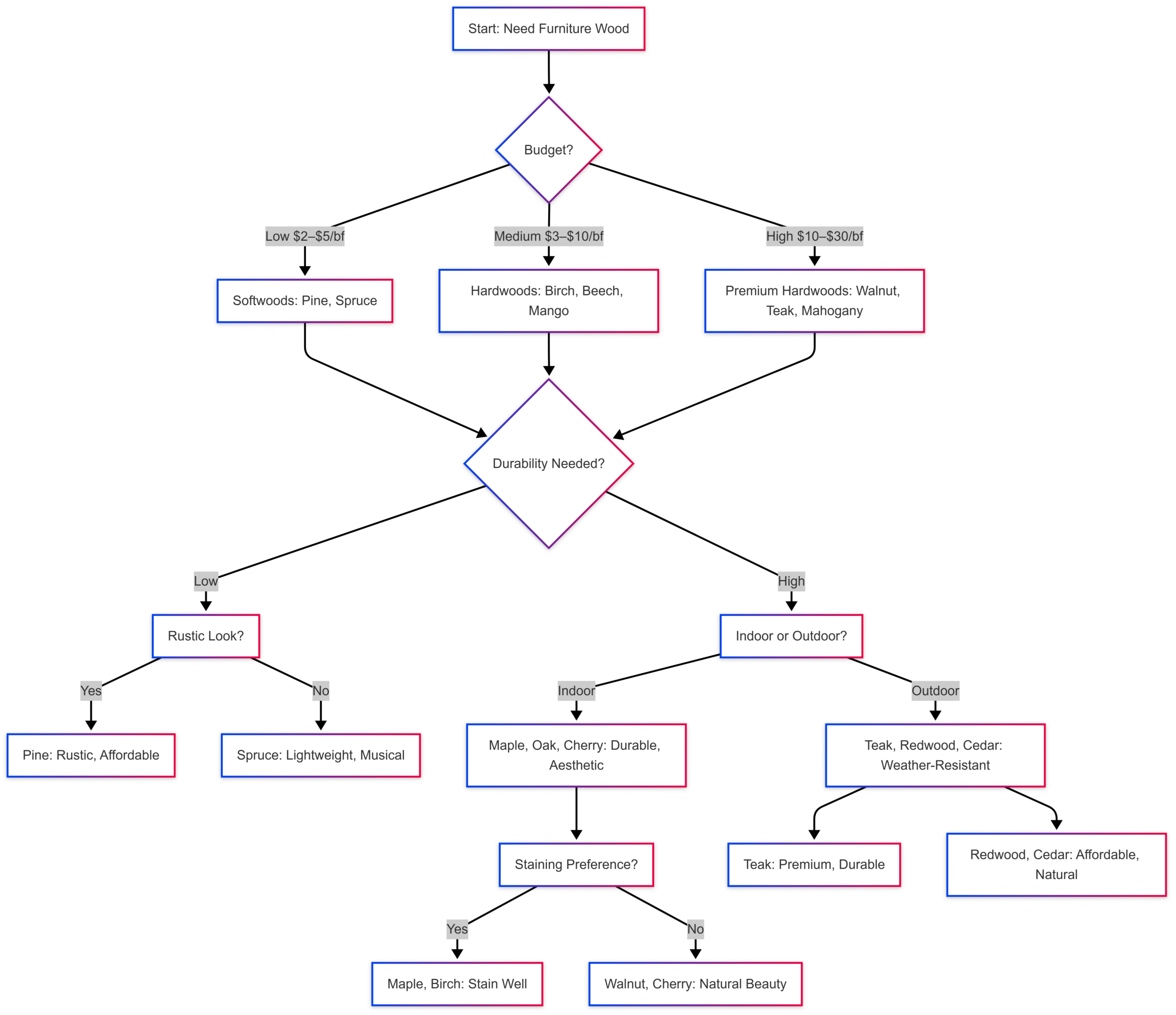
Choosing the Right Wood for Your Furniture
Selecting the ideal wood depends on your project’s requirements:
- Budget: Pine, spruce, and engineered woods like MDF are cost-effective for DIY or budget furniture. Hardwoods like birch and beech offer affordability with better durability.
- Durability: For high-traffic furniture (e.g., dining tables, dressers), choose hardwoods like maple, oak, or walnut. For outdoor pieces, teak, cedar, or redwood excel.
- Aesthetic: Walnut and cherry provide luxurious, natural beauty, while pine offers rustic charm. Maple and birch are versatile for staining.
- Sustainability: Bamboo, mango, and engineered woods like plywood are eco-friendly due to fast growth or recycled materials.
- Workability: Softwoods like pine and cedar are easier to work with for beginners, while hardwoods like walnut and cherry suit intricate designs.
Maintenance Tips for Wood Furniture
To ensure longevity, maintain your wood furniture:
- Clean Regularly: Use a damp cloth and mild soap; avoid harsh chemicals.
- Seal and Protect: Apply wax, oil, or polyurethane to prevent moisture damage.
- Avoid Sunlight: Prolonged exposure can fade or discolor wood.
- Control Humidity: Keep indoor humidity between 40–60% to prevent warping.
Conclusion
Choosing the right wood for your furniture involves balancing cost, durability, and aesthetic preferences. Hardwoods like oak, walnut, and maple offer strength and beauty for high-end pieces, while softwoods like pine and cedar provide affordability and rustic charm. Engineered woods like plywood and MDF are stable and budget-friendly for modern designs. By understanding the pros and cons of each wood type, you can select the perfect material for your next furniture project, ensuring both functionality and timeless appeal.
Please share this Pros and Cons of Different Wood Types for Furniture your friends and do a comment below about your feedback.
We will meet you on next article.
Until you can read, Cutting a 20in Diameter Circle out of Plexiglass
